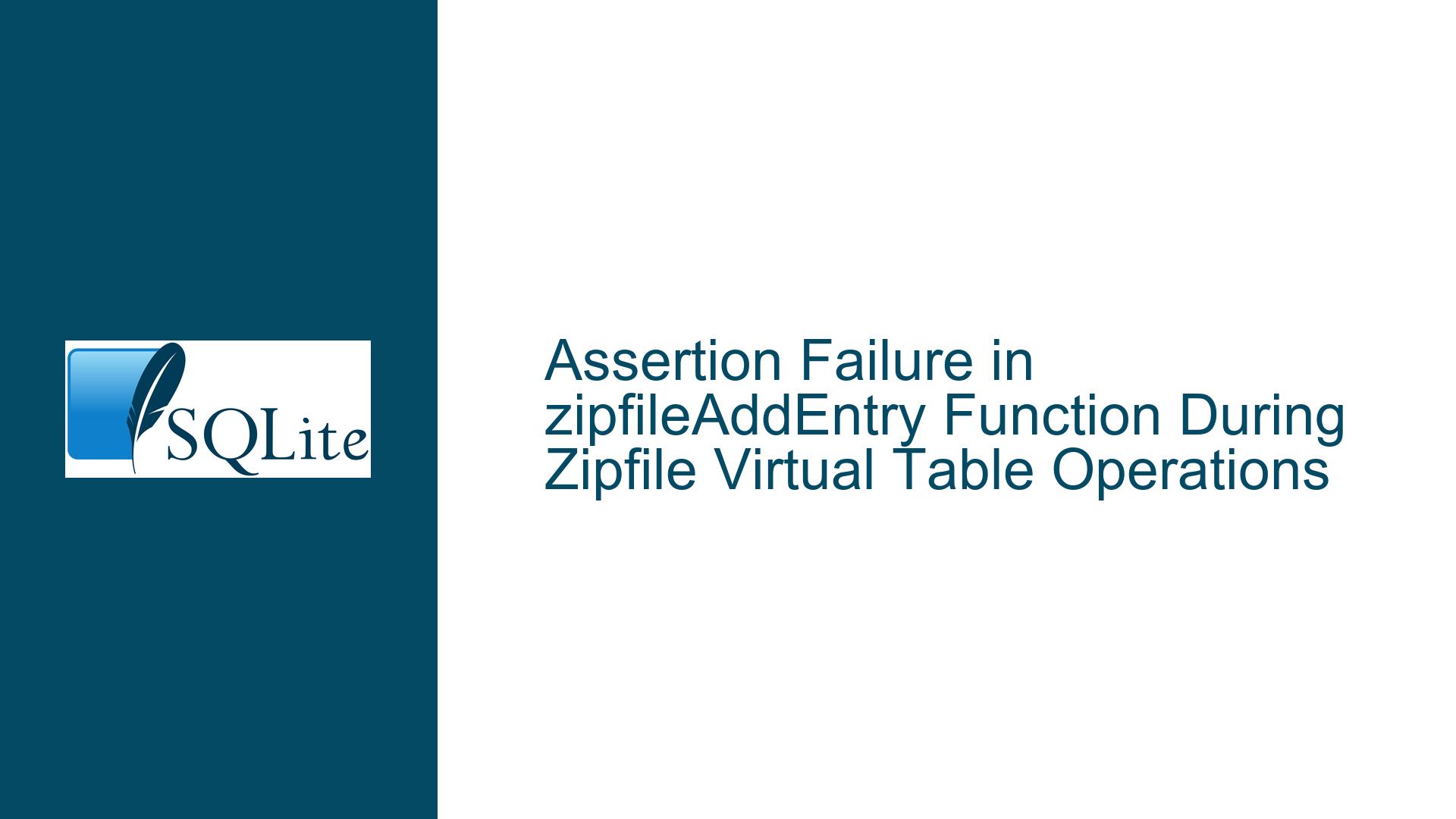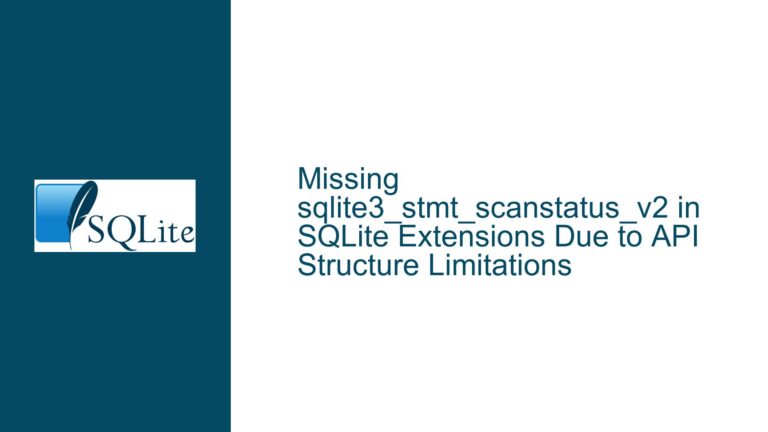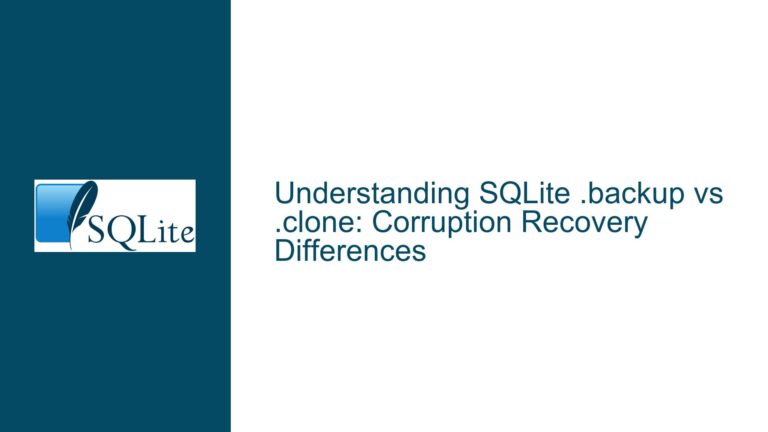Assertion Failure in zipfileAddEntry Function During Zipfile Virtual Table Operations
Understanding the Assertion Failure in zipfileAddEntry Function
The core issue revolves around an assertion failure in the zipfileAddEntry function, which is part of SQLite’s implementation of the zipfile virtual table. This assertion failure occurs under specific conditions when executing a sequence of SQL queries involving the creation of a virtual table, a savepoint, a delete operation, and an insert operation with a RETURNING clause. The assertion failure is triggered on the second execution of the query sequence, indicating a potential issue with the state management of the zipfile virtual table between consecutive operations.
The assertion failure message, sqlite3-asan: shell.c:9168: zipfileAddEntry: Assertion '(pTab->pFirstEntry==0)==(pTab->pLastEntry==0)' failed, suggests that the internal state of the zipfile virtual table is inconsistent. Specifically, the assertion checks whether the pFirstEntry and pLastEntry pointers of the zipfile table are either both null or both non-null. The failure indicates that one of these pointers is null while the other is not, leading to an inconsistent state.
This issue is particularly interesting because it only manifests on the second execution of the query sequence. The first execution successfully creates a zip file named malform, but the second execution triggers the assertion failure. This behavior suggests that the state of the zipfile virtual table is not being properly reset or managed between consecutive operations, leading to an inconsistent state that violates the assertion.
To fully understand this issue, it is essential to delve into the internals of the zipfile virtual table, the role of the zipfileAddEntry function, and the specific sequence of operations that lead to the assertion failure. By examining the code and the execution flow, we can identify the root cause of the issue and propose potential solutions.
Exploring the Role of zipfileAddEntry and Virtual Table State Management
The zipfileAddEntry function is a critical component of the zipfile virtual table implementation in SQLite. This function is responsible for adding new entries to the zip file, and it relies on the internal state of the virtual table to manage the list of entries. The pFirstEntry and pLastEntry pointers are used to maintain a linked list of entries within the zip file, with pFirstEntry pointing to the first entry in the list and pLastEntry pointing to the last entry.
The assertion (pTab->pFirstEntry==0)==(pTab->pLastEntry==0) ensures that the pFirstEntry and pLastEntry pointers are either both null (indicating an empty list) or both non-null (indicating a non-empty list). This assertion is a safeguard to ensure that the internal state of the zipfile virtual table remains consistent throughout its operations.
However, the assertion failure indicates that this consistency check is being violated. This could happen if the zipfile virtual table’s state is not properly reset between operations, leading to a situation where one of the pointers is null while the other is not. For example, if pFirstEntry is null but pLastEntry is not, it would imply that the list is partially initialized, which is an invalid state.
The sequence of operations that triggers this issue involves creating a virtual table, establishing a savepoint, performing a delete operation, and then inserting a new entry with a RETURNING clause. The fact that the issue only occurs on the second execution suggests that the state of the zipfile virtual table is not being properly reset after the first execution, leading to an inconsistent state on the second execution.
To further investigate this issue, it is necessary to examine the code paths involved in the creation, deletion, and insertion of entries in the zipfile virtual table, as well as the handling of savepoints and transactions. By understanding how these operations interact with the virtual table’s state, we can identify the specific conditions that lead to the assertion failure.
Diagnosing and Resolving the Assertion Failure in zipfileAddEntry
To diagnose and resolve the assertion failure in the zipfileAddEntry function, we need to follow a systematic approach that involves examining the code, understanding the execution flow, and identifying the specific conditions that lead to the inconsistent state. Here are the steps to troubleshoot and resolve the issue:
Step 1: Examine the Code Paths for Virtual Table Operations
The first step is to examine the code paths involved in the creation, deletion, and insertion of entries in the zipfile virtual table. This includes understanding how the CREATE VIRTUAL TABLE, DELETE, and INSERT statements interact with the virtual table’s internal state. Specifically, we need to look at how the pFirstEntry and pLastEntry pointers are managed during these operations.
Step 2: Analyze the Savepoint and Transaction Handling
The next step is to analyze how savepoints and transactions are handled in the context of the zipfile virtual table. The use of a savepoint (SAVEPOINT y) in the query sequence suggests that the state of the virtual table may be affected by the transaction management. We need to examine how the savepoint is established, how it affects the virtual table’s state, and how it is released or rolled back.
Step 3: Investigate the State Management Between Consecutive Executions
The fact that the assertion failure only occurs on the second execution of the query sequence indicates that the state of the zipfile virtual table is not being properly reset between executions. We need to investigate how the virtual table’s state is managed between consecutive operations, particularly focusing on how the pFirstEntry and pLastEntry pointers are initialized and reset.
Step 4: Identify the Specific Conditions Leading to the Assertion Failure
Once we have a clear understanding of the code paths and state management, we can identify the specific conditions that lead to the assertion failure. This involves tracing the execution flow and identifying the point at which the pFirstEntry and pLastEntry pointers become inconsistent. We need to determine whether this inconsistency is due to a bug in the code, an issue with transaction management, or a problem with the virtual table’s state reset logic.
Step 5: Propose and Implement a Fix
Based on the findings from the previous steps, we can propose and implement a fix for the assertion failure. This may involve modifying the code to ensure that the pFirstEntry and pLastEntry pointers are properly managed, adding additional checks to prevent inconsistent states, or improving the transaction handling logic. The fix should be thoroughly tested to ensure that it resolves the issue without introducing new problems.
Step 6: Verify the Fix and Ensure Robustness
Finally, we need to verify that the proposed fix resolves the assertion failure and ensures the robustness of the zipfile virtual table. This involves running the original query sequence multiple times to confirm that the issue no longer occurs, as well as testing other related operations to ensure that the fix does not introduce regressions. Additionally, we should consider adding new test cases to the SQLite test suite to catch similar issues in the future.
By following these steps, we can systematically diagnose and resolve the assertion failure in the zipfileAddEntry function, ensuring that the zipfile virtual table operates correctly and consistently in all scenarios.
In conclusion, the assertion failure in the zipfileAddEntry function is a complex issue that requires a deep understanding of SQLite’s virtual table implementation, transaction management, and state handling. By carefully examining the code, analyzing the execution flow, and identifying the specific conditions that lead to the inconsistent state, we can develop a robust solution that resolves the issue and ensures the reliable operation of the zipfile virtual table.






